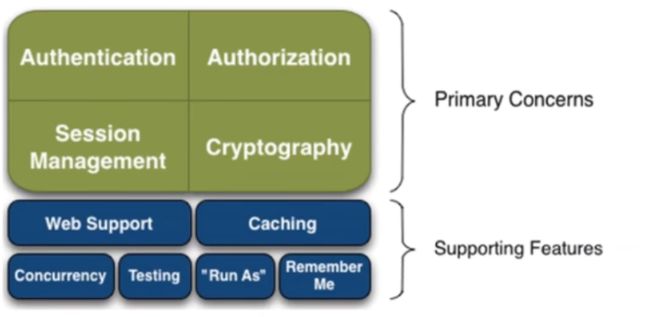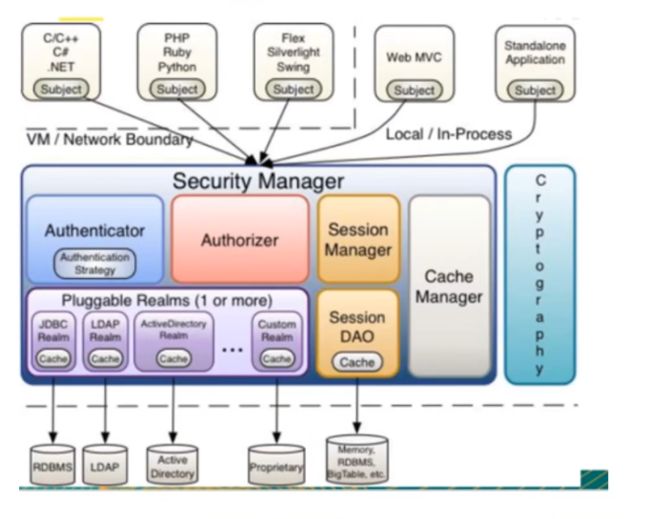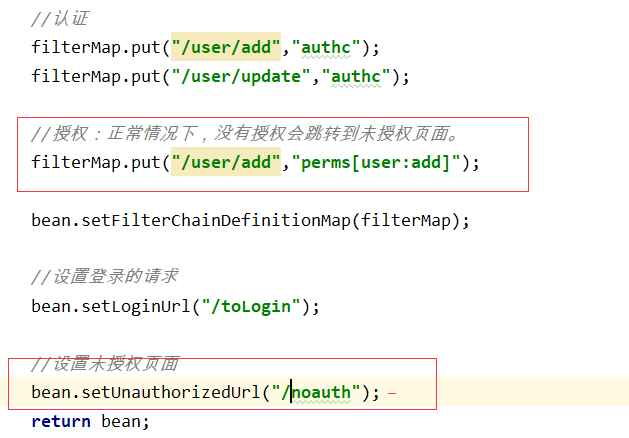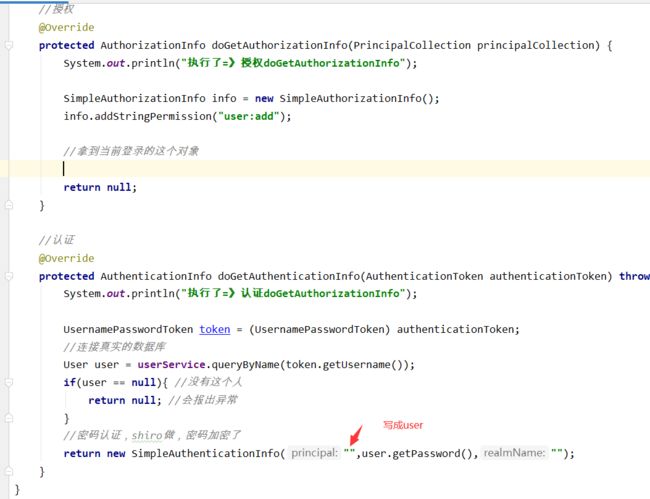一个Java的权限框架-Shiro
S h i r o \textcolor{Orange}{Shiro} Shiro
学 习 过 程 中 的 笔 记 , 方 便 查 阅 学 习 \textcolor{green}{学习过程中的笔记,方便查阅学习} 学习过程中的笔记,方便查阅学习
笔 记 总 结 来 源 于 视 频 B 站 狂 神 说 \textcolor{green}{笔记总结来源于视频B站狂神说} 笔记总结来源于视频B站狂神说
欢迎各位小伙伴关注点赞⭐️收藏留言
Shiro
-
-
- 1.shiro简介
- 2.快速实践
- 3.SpringBoot整合Shiro环境搭建
- 4.实现登录拦截
- 5.实现用户验证
- 6.整合Mybaits
- 请求授权实现
- shiro整合thymeleaf
-
1.shiro简介
-
Apach Shiro是一个Java的安全(权限)框架
-
可以非常容易的开发出足够好的应用,其不仅可以用在javaSE环境,也可以用在JavaEE环境
-
可以完成认证、授权、加密、会话管理,web集成,缓存等。
-
官网:https://shiro.apache.org/
-
点击download,可以直接下载。也可以直接依赖包
github地址:https://github.com/apache/shiro
功能
- Authentication:身份认证、登录、验证用户是不是拥有相应的身份;
- Authorization:授权,即权限验证,验证某个已认证的用户是否拥有某个权限,即判断用户能否进行什么操作,如:验证某个用户是否拥有某个角色,或者细粒度的验证某个用户对某个资源是否具有某个权限。
- Session Manager:会话管理,即用户登录后就是第一次会话,在没有退出之前,它的所有信息都在会话中,会话可以是普通的javaSE环境,也可以是Web环境;
- Cryptography:加密,保护数据的安全性,如密码加密存储到数据库中,而不是明文存储;
- Web Support:Web支持,可以非常容易的集成到Web环境;
- Caching:缓存,比如用户登录后,其用户信息,拥有的角色、权限不必每次去查,这样可以提高效率
- Concurrency:Shiro支持多线程应用的并发验证,即,如在一个线程中开启另一个线程,能把权限自动的传播过去。
- Testing:提供测试支持;
- Run as:允许一个用户假装为另一个用户(如果他们允许)的身份进行访问
- Remember Me:记住我,这个是非常常见的功能,即一次登录后,下次再来的话就不用的登录了。
shiro架构(外部)
- subject:应用代码直接交互的对象是Subject,也就是说Shiro的对外API核心就是Subject,Subject代表了当前的用户,这个用户不一定是一个具体的人,与当前应用交互的任何东西都是subject,如网络爬虫,机器人等,与subject的所有交互都会委托给SecurityManager;subject其实是一个门面,SecurityManager才是实际的执行者。
- securityManager:安全管理器,即所有与安全有关的操作都会与SecurityManager交互,并且它管理着所有的subject,可以看出它是shiro的核心,它负责与Shiro的其他组件进行交互,它相当于SPringMVC的DispatcherServlet的角色。
- Realm:Shiro从Realm获取安全数据(如用户,角色,权限),就是说SecurityManager要验证用户身份,那么它需要从Realm获取相应的用户进行比较,来确定用户的身份是否合法;也需要从Realm得到用户相应的角色,权限,进行验证用户的操作是否能够进行,可以把Realm看成dataSource;
shiro架构(内部)
- subject:任何可以与应用交互的”用户“
- SecurityManager:相当于SpringMVC中的DispatcherServet;是shiro的心脏,所有具体的交互都通过SecurityManager进行控制,它管理着所有的Subject,且负责进行认证,授权,会话及缓存的管理。
- Authenticator:负责Subject认证,是一个扩展点,可以自定义实现;可以使用认证策略,即什么情况下算用户认证通过了;
- Authorizer:授权器,即访问控制器,用来决定主体是否有权限进行相应的操作;即控制着用户能访问应用中的哪些功能;
- Realm:可以有一个或者多个的realm,可以认为是安全实体数据源,即用于获取安全实体的,可以用JDBC实现,也可以是内存实现等等,由用户提供;所以一般在应用中都需要实现自己的realm
- SessionManager:管理Session生命周期的组件,而Shiro并不仅仅可以用在web环境,也可以用在普通的JavaSE环境中
- CacheManager:缓存控制器,来管理如用户、角色,权限等缓存的;因为这些数据基本上很少改变,放到缓存中可以提高访问的性能;
- Cryptography:密码模块,Shiro提高了一些常见的加密组件用于密码加密,解密等
2.快速实践
十分钟入门官网:https://shiro.apache.org/tutorial.html
-
首先创建一个普通的Maven项目。
-
为了后续的方便,我们可以将
src删除,然后创建一个module:hello-shiro。 -
接下来我们先看依赖。https://github.com/apache/shiro/blob/main/samples/quickstart/pom.xml
我们可以在里面看到我们需要的依赖,然后我们可以依赖再在https://shiro.apache.org/download.html#180官网这里找到对应的版本号,直接加进去。
- 再一个简单的办法直接看10分钟入门https://shiro.apache.org/tutorial.html。这里注意把范围去掉,官网是test,非test环境是不能用的。
<dependencies> <dependency> <groupId>org.apache.shirogroupId> <artifactId>shiro-coreartifactId> <version>1.8.0version> dependency> <dependency> <groupId>org.slf4jgroupId> <artifactId>slf4j-simpleartifactId> <version>1.7.21version> dependency> <dependency> <groupId>org.slf4jgroupId> <artifactId>jcl-over-slf4jartifactId> <version>1.7.21version> dependency> <dependency> <groupId>commons-logginggroupId> <artifactId>commons-loggingartifactId> <version>1.2version> dependency> dependencies> -
然后再返回去查看配置文件
在
resources下-
创建
log4j2.xml<Configuration name="ConfigTest" status="ERROR" monitorInterval="5"> <Appenders> <Console name="Console" target="SYSTEM_OUT"> <PatternLayout pattern="%d{HH:mm:ss.SSS} [%t] %-5level %logger{36} - %msg%n"/> Console> Appenders> <Loggers> <Logger name="org.springframework" level="warn" additivity="false"> <AppenderRef ref="Console"/> Logger> <Logger name="org.apache" level="warn" additivity="false"> <AppenderRef ref="Console"/> Logger> <Logger name="net.sf.ehcache" level="warn" additivity="false"> <AppenderRef ref="Console"/> Logger> <Logger name="org.apache.shiro.util.ThreadContext" level="warn" additivity="false"> <AppenderRef ref="Console"/> Logger> <Root level="info"> <AppenderRef ref="Console"/> Root> Loggers> Configuration> -
在
resources下创建shiro.ini是灰色的不要怕。这是因为没有下载插件。不下载也是可以用的。
# # Licensed to the Apache Software Foundation (ASF) under one # or more contributor license agreements. See the NOTICE file # distributed with this work for additional information # regarding copyright ownership. The ASF licenses this file # to you under the Apache License, Version 2.0 (the # "License"); you may not use this file except in compliance # with the License. You may obtain a copy of the License at # # http://www.apache.org/licenses/LICENSE-2.0 # # Unless required by applicable law or agreed to in writing, # software distributed under the License is distributed on an # "AS IS" BASIS, WITHOUT WARRANTIES OR CONDITIONS OF ANY # KIND, either express or implied. See the License for the # specific language governing permissions and limitations # under the License. # # ============================================================================= # Quickstart INI Realm configuration # # For those that might not understand the references in this file, the # definitions are all based on the classic Mel Brooks' film "Spaceballs". ;) # ============================================================================= # ----------------------------------------------------------------------------- # Users and their assigned roles # # Each line conforms to the format defined in the # org.apache.shiro.realm.text.TextConfigurationRealm#setUserDefinitions JavaDoc # ----------------------------------------------------------------------------- [users] # user 'root' with password 'secret' and the 'admin' role root = secret, admin # user 'guest' with the password 'guest' and the 'guest' role guest = guest, guest # user 'presidentskroob' with password '12345' ("That's the same combination on # my luggage!!!" ;)), and role 'president' presidentskroob = 12345, president # user 'darkhelmet' with password 'ludicrousspeed' and roles 'darklord' and 'schwartz' darkhelmet = ludicrousspeed, darklord, schwartz # user 'lonestarr' with password 'vespa' and roles 'goodguy' and 'schwartz' lonestarr = vespa, goodguy, schwartz # ----------------------------------------------------------------------------- # Roles with assigned permissions # # Each line conforms to the format defined in the # org.apache.shiro.realm.text.TextConfigurationRealm#setRoleDefinitions JavaDoc # ----------------------------------------------------------------------------- [roles] # 'admin' role has all permissions, indicated by the wildcard '*' admin = * # The 'schwartz' role can do anything (*) with any lightsaber: schwartz = lightsaber:* # The 'goodguy' role is allowed to 'drive' (action) the winnebago (type) with # license plate 'eagle5' (instance specific id) goodguy = winnebago:drive:eagle5
-
-
helloWorld
在java目录下创建
Qucikstart.java/* * Licensed to the Apache Software Foundation (ASF) under one * or more contributor license agreements. See the NOTICE file * distributed with this work for additional information * regarding copyright ownership. The ASF licenses this file * to you under the Apache License, Version 2.0 (the * "License"); you may not use this file except in compliance * with the License. You may obtain a copy of the License at * * http://www.apache.org/licenses/LICENSE-2.0 * * Unless required by applicable law or agreed to in writing, * software distributed under the License is distributed on an * "AS IS" BASIS, WITHOUT WARRANTIES OR CONDITIONS OF ANY * KIND, either express or implied. See the License for the * specific language governing permissions and limitations * under the License. */ /** * Simple Quickstart application showing how to use Shiro's API. * * @since 0.9 RC2 */ import org.apache.shiro.SecurityUtils; import org.apache.shiro.authc.*; import org.apache.shiro.config.IniSecurityManagerFactory; import org.apache.shiro.mgt.SecurityManager; import org.apache.shiro.session.Session; import org.apache.shiro.subject.Subject; import org.apache.shiro.util.Factory; import org.slf4j.Logger; import org.slf4j.LoggerFactory; public class Quickstart { private static final transient Logger log = LoggerFactory.getLogger(Quickstart.class); public static void main(String[] args) { // The easiest way to create a Shiro SecurityManager with configured // realms, users, roles and permissions is to use the simple INI config. // We'll do that by using a factory that can ingest a .ini file and // return a SecurityManager instance: // Use the shiro.ini file at the root of the classpath // (file: and url: prefixes load from files and urls respectively): Factory<SecurityManager> factory = new IniSecurityManagerFactory("classpath:shiro.ini"); SecurityManager securityManager = factory.getInstance(); // for this simple example quickstart, make the SecurityManager // accessible as a JVM singleton. Most applications wouldn't do this // and instead rely on their container configuration or web.xml for // webapps. That is outside the scope of this simple quickstart, so // we'll just do the bare minimum so you can continue to get a feel // for things. SecurityUtils.setSecurityManager(securityManager); // Now that a simple Shiro environment is set up, let's see what you can do: // get the currently executing user: Subject currentUser = SecurityUtils.getSubject(); // Do some stuff with a Session (no need for a web or EJB container!!!) Session session = currentUser.getSession(); session.setAttribute("someKey", "aValue"); String value = (String) session.getAttribute("someKey"); if (value.equals("aValue")) { log.info("Retrieved the correct value! [" + value + "]"); } // let's login the current user so we can check against roles and permissions: if (!currentUser.isAuthenticated()) { UsernamePasswordToken token = new UsernamePasswordToken("lonestarr", "vespa"); token.setRememberMe(true); try { currentUser.login(token); } catch (UnknownAccountException uae) { log.info("There is no user with username of " + token.getPrincipal()); } catch (IncorrectCredentialsException ice) { log.info("Password for account " + token.getPrincipal() + " was incorrect!"); } catch (LockedAccountException lae) { log.info("The account for username " + token.getPrincipal() + " is locked. " + "Please contact your administrator to unlock it."); } // ... catch more exceptions here (maybe custom ones specific to your application? catch (AuthenticationException ae) { //unexpected condition? error? } } //say who they are: //print their identifying principal (in this case, a username): log.info("User [" + currentUser.getPrincipal() + "] logged in successfully."); //test a role: if (currentUser.hasRole("schwartz")) { log.info("May the Schwartz be with you!"); } else { log.info("Hello, mere mortal."); } //test a typed permission (not instance-level) if (currentUser.isPermitted("lightsaber:wield")) { log.info("You may use a lightsaber ring. Use it wisely."); } else { log.info("Sorry, lightsaber rings are for schwartz masters only."); } //a (very powerful) Instance Level permission: if (currentUser.isPermitted("winnebago:drive:eagle5")) { log.info("You are permitted to 'drive' the winnebago with license plate (id) 'eagle5'. " + "Here are the keys - have fun!"); } else { log.info("Sorry, you aren't allowed to drive the 'eagle5' winnebago!"); } //all done - log out! currentUser.logout(); System.exit(0); } } -
运行测试
出现这个问题是没有一个依赖
<dependency> <groupId>commons-logginggroupId> <artifactId>commons-loggingartifactId> <version>1.2version> dependency>这个问题是由于依赖的范围有问题,需要把test删除
完美结果
-
主要方法
//获取当前的用户对象 Subject Subject currentUser = SecurityUtils.getSubject(); //通过当前用户拿到session Session session = currentUser.getSession(); //判断当前的用户是否被认证 currentUser.isAuthenticated() //获取存储的principal currentUser.getPrincipal() //设置角色 currentUser.hasRole("schwartz") //粗粒度 currentUser.isPermitted("lightsaber:wield")) //细粒度 currentUser.isPermitted("winnebago:drive:eagle5") //注销 currentUser.logout();
3.SpringBoot整合Shiro环境搭建
-
创建spring项目,勾选springweb和thymeleaf
-
测试基础环境
-
在
templates下创建index.html,并将命名空间及标签写入。DOCTYPE html> <html lang="en" xmlns:th="http://www.thymeleaf.org"> <head> <meta charset="UTF-8"> <title>Titletitle> head> <body> 首页 <p th:text = "${msg}">p> body> html> -
创建
controllerpackage com.hxl.controller; import org.springframework.stereotype.Controller; import org.springframework.ui.Model; import org.springframework.web.bind.annotation.RequestMapping; @Controller public class MyController { @RequestMapping({"/","/index"}) public String toIndex(Model model){ model.addAttribute("msg","hello,Shiro"); return "index"; } } -
启动测试,出现下述则表示环境搭好了
-
-
整合Shiro
-
导入依赖包
<dependency> <groupId>org.apache.shirogroupId> <artifactId>shiro-springartifactId> <version>1.7.1version> dependency> -
编写配置类
创建
config的包进行编写-
编写ShiroConfig
package com.hxl.config; import org.springframework.context.annotation.Configuration; @Configuration public class ShiroConfig { /*下面三个对应的三大核心对象,配的时候倒着配,先创建对象,在接管,后连到前端*/ //ShiroFilterFactoryBean //DefaultWebSecurityManager //创建realm对象;需要自定义类 } -
编写我们的自定义类
package com.hxl.config; import org.apache.shiro.authc.AuthenticationException; import org.apache.shiro.authc.AuthenticationInfo; import org.apache.shiro.authc.AuthenticationToken; import org.apache.shiro.authz.AuthorizationInfo; import org.apache.shiro.realm.AuthorizingRealm; import org.apache.shiro.subject.PrincipalCollection; //自定义的UserRealm ,需要继承AuthorizingRealm public class UserRealm extends AuthorizingRealm { //授权 @Override protected AuthorizationInfo doGetAuthorizationInfo(PrincipalCollection principalCollection) { System.out.println("执行了=》授权doGetAuthorizationInfo"); return null; } //认证 @Override protected AuthenticationInfo doGetAuthenticationInfo(AuthenticationToken authenticationToken) throws AuthenticationException { System.out.println("执行了=》认证doGetAuthorizationInfo"); return null; } } -
定义完之后就可以用了
package com.hxl.config; import org.apache.catalina.User; import org.apache.shiro.spring.web.ShiroFilterFactoryBean; import org.apache.shiro.web.mgt.DefaultWebSecurityManager; import org.springframework.beans.factory.annotation.Qualifier; import org.springframework.context.annotation.Bean; import org.springframework.context.annotation.Configuration; @Configuration public class ShiroConfig { /*下面三个对应的三大核心对象,配的时候倒着配,先创建对象,在接管,后连到前端*/ //ShiroFilterFactoryBean:3 /*这里同样可以使用之前的方法,在DefaultWebSecurityManager前加@Qualifier("方法名") * 但是名字太长了,所以还可以使用另外一种方式进行绑定,这就需要修改DefaultWebSecurityManager这个的Bean。添加别名 * */ @Bean public ShiroFilterFactoryBean getShiroFilterFactoryBean(@Qualifier("securityManger") DefaultWebSecurityManager defaultWebSecurityManager){ ShiroFilterFactoryBean bean = new ShiroFilterFactoryBean(); //设置安全管理器 bean.setSecurityManager(defaultWebSecurityManager); return bean; } //DefaultWebSecurityManager:2 /*public DefaultWebSecurityManager getDefaultWebSecurityManager(UserRealm userRealm){ 这个没有把下面的方法绑定过来 */ @Bean(name = "securityManger") public DefaultWebSecurityManager getDefaultWebSecurityManager(@Qualifier("userRealm") UserRealm userRealm){ DefaultWebSecurityManager securityManager = new DefaultWebSecurityManager(); //关闭UserRealm securityManager.setRealm(userRealm); return securityManager; } //创建realm对象;需要自定义类:1 @Bean public UserRealm userRealm(){ return new UserRealm(); } //这个之后我们写的类就被spring托管了 }
-
-
增加页面
增加和更新页面仅作业测试页面先写上内容方便区分即可。
在首页上增加可以跳转的连接
<a th:href="@{/user/add}">adda> <a th:href="@{/user/update}">updatea> -
controller中进行跳转
@RequestMapping("/user/add") public String add(){ return "user/add"; } @RequestMapping("/user/update") public String update(){ return "user/update"; } -
测试:能成功跳转即可。
-
4.实现登录拦截
-
首先先增加一个登录页面,在templates目录下
DOCTYPE html> <html lang="en"> <head> <meta charset="UTF-8"> <title>登录title> head> <body> <form action=""> <p>用户名:<input type="text" name="username">p> <p>密码:<input type="text" name="password">p> <p><input type="submit">p> form> body> html> -
controller中增加请求
@RequestMapping("/toLogin") public String toLogin(){ return "login"; } -
在ShiroConfig中添加
@Bean public ShiroFilterFactoryBean getShiroFilterFactoryBean(@Qualifier("securityManger") DefaultWebSecurityManager defaultWebSecurityManager){ ShiroFilterFactoryBean bean = new ShiroFilterFactoryBean(); //设置安全管理器 bean.setSecurityManager(defaultWebSecurityManager); //添加shiro的内置过滤器 /* * anon:无需认证就可以访问 * authc:必须认证了才能访问 * user:必须拥有记住我功能才能用 * perms:拥有对某个资源的权限才能访问 * role:拥有某个角色权限才能访问 * */ Map<String, String> filterMap = new LinkedHashMap<>(); filterMap.put("/user/add","authc"); filterMap.put("/user/update","authc"); bean.setFilterChainDefinitionMap(filterMap); //设置登录的请求 bean.setLoginUrl("/toLogin"); return bean; }
5.实现用户验证
-
在controller中增加请求
@RequestMapping("/login") public String login(String username, String password){ //获取当前的用户 Subject subject = SecurityUtils.getSubject(); //封装用户的登录数据 UsernamePasswordToken token = new UsernamePasswordToken(username, password); }注意还没结束呢,我们这里有了请求,那么在前端就需要提交请求
-
login.html这里的
actionDOCTYPE html> <html lang="en" xmlns:th="http://www.thymeleaf.org"> <head> <meta charset="UTF-8"> <title>登录title> head> <body> <form th:action="@{/login}"> <p>用户名:<input type="text" name="username">p> <p>密码:<input type="text" name="password">p> <p><input type="submit">p> form> body> html> -
有了令牌该怎么办呢,可以看一下
Quickstart。里面是怎么弄得 -
那么就可以在我们的controller中添加
@RequestMapping("/login") public String login(String username, String password, Model model){ //获取当前的用户 Subject subject = SecurityUtils.getSubject(); //封装用户的登录数据 UsernamePasswordToken token = new UsernamePasswordToken(username, password); try{ subject.login(token); //执行了登录的方法,如果没有异常就说明ok return "index"; }catch(UnknownAccountException e){ model.addAttribute("msg","用户名错误"); return "login"; }catch (IncorrectCredentialsException e){ model.addAttribute("msg","密码错误"); return "login"; } }有了提示信息,前端再把提示信息加上
<p th:text="${msg}" style="color: red">p> -
那么前端传过来的数据和数据库中的数据怎么判断呢?
这就需要在UserRealm里面进行认证
//认证 @Override protected AuthenticationInfo doGetAuthenticationInfo(AuthenticationToken authenticationToken) throws AuthenticationException { System.out.println("执行了=》认证doGetAuthorizationInfo"); //数据库中取,用户名和密码 String name = "root"; String password = "123456"; UsernamePasswordToken userToken = (UsernamePasswordToken) authenticationToken; if(!userToken.getUsername().equals(name)){ return null;//抛出异常:UnknownAccountException } //密码认证,shiro做 return new SimpleAuthenticationInfo("",password,""); } -
测试
登录成功后,一切都可以访问了。
6.整合Mybaits
-
先导入依赖
除了之前的依赖还需要下面这些。
<dependency> <groupId>mysqlgroupId> <artifactId>mysql-connector-javaartifactId> dependency> <dependency> <groupId>org.mybatis.spring.bootgroupId> <artifactId>mybatis-spring-boot-starterartifactId> <version>2.2.1version> dependency> <dependency> <groupId>org.projectlombokgroupId> <artifactId>lombokartifactId> dependency> <dependency> <groupId>log4jgroupId> <artifactId>log4jartifactId> <version>1.2.17version> dependency> <dependency> <groupId>com.alibabagroupId> <artifactId>druidartifactId> <version>1.2.8version> dependency> -
配置文件yml
spring: datasource: username: root password: 123456 url: jdbc:mysql://localhost:3306/jdbc?serverTimezone=UTC&useUnicode=true&characterEncoding=utf-8 driver-class-name: com.mysql.cj.jdbc.Driver # 整合mybatis mybatis: type-aliases-package: com.hxl.pojo mapper-locations: classpath:mapper/*.xml -
创建resources/mapper。这个文件夹
-
创建
pojo,mapper,service层并写入package com.hxl.pojo; import lombok.AllArgsConstructor; import lombok.Data; import lombok.NoArgsConstructor; import java.sql.Date; @Data @AllArgsConstructor @NoArgsConstructor public class User { private int id; private String name; private String password; private String email; private Date birthday; }package com.hxl.mapper; import com.hxl.pojo.User; import org.apache.ibatis.annotations.Mapper; import org.springframework.stereotype.Repository; //这个注解表示本类是一个mybatis的mapper类 @Mapper @Repository //注解是将接口的一个实现类交给spring管理。 public interface UserMapper { //通过名字获取 public User queryByName(String name); }package com.hxl.service; import com.hxl.pojo.User; public interface UserService { public User queryByName(String name); }package com.hxl.service; import com.hxl.mapper.UserMapper; import com.hxl.pojo.User; import org.springframework.beans.factory.annotation.Autowired; import org.springframework.stereotype.Service; @Service public class UserServiceImpl implements UserService { @Autowired UserMapper userMapper; @Override public User queryByName(String name) { return userMapper.queryByName(name); } } -
把resources/mapper补上
DOCTYPE mapper PUBLIC "-//mybatis.org//DTD Mapper 3.0//EN" "http://mybatis.org/dtd/mybatis-3-mapper.dtd"> <mapper namespace="com.hxl.mapper.UserMapper"> <select id="queryByName" parameterType="String" resultType="User"> select * from users where name = #{name} select> mapper> -
测试
在测试类中编写
package com.hxl; import com.hxl.service.UserServiceImpl; import org.junit.jupiter.api.Test; import org.springframework.beans.factory.annotation.Autowired; import org.springframework.boot.test.context.SpringBootTest; @SpringBootTest class ShiroSpringbootApplicationTests { @Autowired UserServiceImpl userService; @Test void contextLoads() { System.out.println(userService.queryByName("老大")); } } -
查看输出
-
遇到的问题:
如果遇到
If you want an embedded database (H2, HSQL or Derby), please put it on the c资源过滤以及数据库配置没有生效问题。把它放在build中<resources> <resource> <directory>src/main/javadirectory> <includes> <include>**/*.xmlinclude> <include>**/*.ymlinclude> includes> <filtering>truefiltering> resource> <resource> <directory>src/main/resourcesdirectory> <includes> <include>**/*.xmlinclude> <include>**/*.ymlinclude> includes> <filtering>truefiltering> resource> resources> -
真实的人进行登录拦截
@Autowired UserService userService; //认证 @Override protected AuthenticationInfo doGetAuthenticationInfo(AuthenticationToken authenticationToken) throws AuthenticationException { System.out.println("执行了=》认证doGetAuthorizationInfo"); UsernamePasswordToken token = (UsernamePasswordToken) authenticationToken; //连接真实的数据库 User user = userService.queryByName(token.getUsername()); if(user == null){ //没有这个人 return null; //会报出异常 } //密码认证,shiro做,密码加密了 return new SimpleAuthenticationInfo("",user.getPassword(),""); }
请求授权实现
当一个人没有某操作的功能权限,是不能进入的。那么应该怎么实现呢?
在ShiroConfig中进行编写
//授权:正常情况下,没有授权会跳转到未授权页面。
filterMap.put("/user/add","perms[user:add]");
filterMap.put("/user/update","perms[user:update]");
bean.setFilterChainDefinitionMap(filterMap);
//设置未授权页面
bean.setUnauthorizedUrl("/noauth");
同时在controller中增加一个请求
@RequestMapping("/noauth")
@ResponseBody
public String noauth(){
return "未经授权不能操作";
}
此时只是简单的实现。而更完善的需要在UserRealm中实现
同时需要在数据库中增加一列,用户的权限
给root用户增加一个add权限
这个时候就需要把pojo类里面也增加上字段perms
最后在授权的UserRealm
//授权
@Override
protected AuthorizationInfo doGetAuthorizationInfo(PrincipalCollection principalCollection) {
System.out.println("执行了=》授权doGetAuthorizationInfo");
SimpleAuthorizationInfo info = new SimpleAuthorizationInfo();
info.addStringPermission("user:add");
//拿到当前登录的这个对象
Subject subject = SecurityUtils.getSubject();
User principal = (User) subject.getPrincipal();//拿到User对象
//设置当前用户的权限
info.addStringPermission(principal.getPerms());
return null;
}
shiro整合thymeleaf
下载依赖包
<dependency>
<groupId>com.github.theborakompanionigroupId>
<artifactId>thymeleaf-extras-shiroartifactId>
<version>2.0.0version>
dependency>
在shiroConfig中编写
//整合ShiroDialect:用来整合shiro和thymeleaf
public ShiroDialect getShiroDialect(){
return new ShiroDialect();
}
修改首页
DOCTYPE html>
<html lang="en" xmlns:th="http://www.thymeleaf.org"
xmlns:shiro="http://www.pollix.at/thymeleaf/shiro">
<head>
<meta charset="UTF-8">
<title>Titletitle>
head>
<body>
首页
<p>
<a th:href="@{/toLogin}">登录a>
p>
<p th:text = "${msg}">p>
<div shiro:hasPermission="'user:add'">
<a th:href="@{/user/add}">adda>
div>
<div shiro:hasPermission="'user:update'">
<a th:href="@{/user/update}">updatea>
div>
body>
html>
测试:
这样之后,登录用户不同显示不同,如果权限只有add,那么只会显示add
如果显示两个add,那么是之前授权的时候有一段代码info.addStringPermission("user:add");注释掉即可
发现登录成功之后还有登录按钮。需要在登录外面的p标签外包一个



















